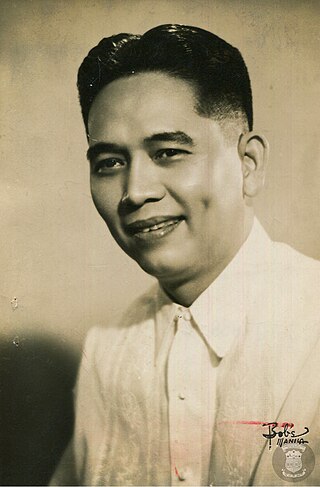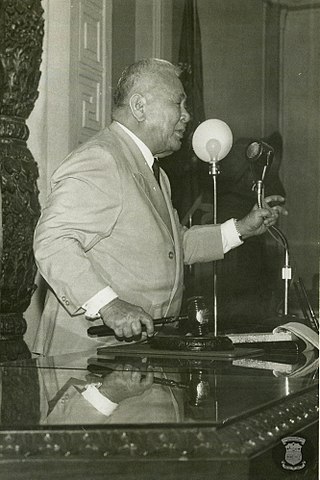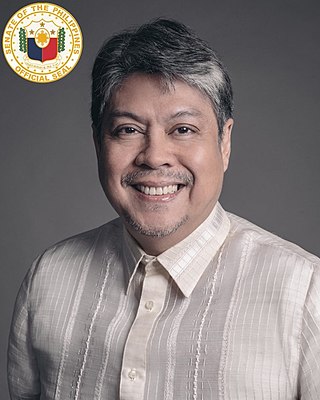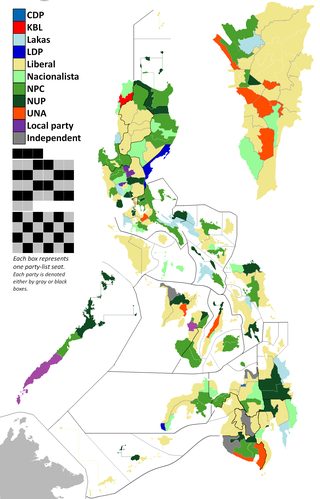
The 1992 election of members to the Senate of the Philippines was the 24th election to the Senate of the Philippines. It was held on Monday, May 11, 1992. This was the first general election under the 1987 Philippine Constitution. An estimated 80,000 candidates ran for 17,000 posts, from the presidency all the way down to municipal councilors.

A senatorial election was held on November 11, 1969 in the Philippines. While incumbent President Ferdinand Marcos won an unprecedented second full term as President of the Philippines, and his running mate, incumbent Vice President Fernando Lopez was also elected to a third full term as Vice President of the Philippines, their Nacionalista Party-mates also won six of the eight contested seats in the Philippine Senate increasing their majority in the Senate.

A senatorial election was held on November 9, 1965 in the Philippines. The Nacionalista Party wrestled back control of the Senate; originally a Liberal, Senate President Ferdinand Marcos defected to the Nacionalistas, became their presidential candidate and won this year's election.

A senatorial election was held on November 14, 1961 in the Philippines. The two candidates of the Progressive Party, guest candidates of the Liberal Party, topped the election, while the Liberals themselves won four seats cutting the Nacionalista Party's majority to 13 seats in the 24-seat Philippine Senate.

A senatorial election was held on November 12, 1957 in the Philippines. The Nacionalista Party, despite losing two seats to the Liberal Party still held the Senate with twenty seats. The Liberals who won were actor Rogelio de la Rosa and former basketball player Ambrosio Padilla.

Elections for the members of the Senate were held on November 10, 1953 in the Philippines. Incumbent President Elpidio Quirino of the Liberal Party lost his opportunity to get a second full term as President of the Philippines to former Defense Secretary Ramon Magsaysay of the Nacionalista Party. Quirino's running mate, Senator Jose Yulo lost to Senator Carlos P. Garcia. Vice President Fernando Lopez did not run for re-election and ran for the Senate instead, in which he emerged as the candidate with the most votes. This was the first time that an elected president did not come from the Senate. To further compound the Liberal Party's woes, they also failed to win any seats in the Senate in this election.

Elections for the members of the Senate were held on November 8, 1949 in the Philippines.

Elections for the members of the Senate were held on April 23, 1946, in the Philippines.

A senatorial election was held on November 8, 1971 in the Philippines. The opposition Liberal Party won five seats in the Philippine Senate while three seats were won by the Nacionalista Party, the administration party; this was seen as a consequence of the Plaza Miranda bombing on August 21, 1971, which wounded all of the Liberal Party's candidates and almost took the lives of John Henry Osmeña and Jovito Salonga. Their terms as senators were cut short as a result of the declaration of martial law by President Ferdinand Marcos on September 23, 1972.

A senatorial election was held on November 14, 1967, in the Philippines. The 1967 election for the members of the Philippine Senate were also known as the 1967 midterm election, as the date where the elected candidates take office falls halfway through President Ferdinand Marcos' four-year term. The administration Nacionalista Party won seven seats in the Philippine Senate while the Liberal Party won one seat; the Nacionalistas got the majority in the Senate after having twelve of the 24 seats in the Senate prior to the election.

A senatorial election was held on November 12, 1963 in the Philippines. The 1963 elections were known as a midterm election as the date when the elected officials take office falls halfway through President Diosdado Macapagal's four-year term.

A senatorial election in the Philippines was held on November 8, 1955. This was a midterm election, the date when the winners took office falling halfway through President Ramon Magsaysay's four-year term.

A senatorial election was held in the Philippines on November 13, 1951. The election was known as a midterm election as the date when elected candidates take office falls halfway through President Elpidio Quirino's four-year term.

Elections for the Senate of the Philippines were held on November 11, 1947, with eight of the 24 seats in the Senate being contested. These eight seats were elected regularly; the winners were eligible to serve six-year terms from December 30, 1947, until December 30, 1953. Gubernatorial and local elections were held on the same date.

The 2010 election of members to the Senate of the Philippines was the 30th election to the Senate of the Philippines. It was held on Monday, May 10, 2010, to elect 12 of the 24 seats in the Senate. The winners in this election joined the winners of the 2007 election to form the 15th Congress of the Philippines. The senators elected in 2007 will serve until June 30, 2013, while the senators elected in this election will serve up to June 30, 2016. The 2010 presidential election, elections to the House of Representatives as well as local elections occurred on the same date. The Philippines uses plurality-at-large voting for seats in the Senate: the twelve candidates with the highest number of votes wins the twelve seats up for election.

The 2010 Philippine House of Representatives elections were held on May 10, 2010, to elect members to the House of Representatives of the Philippines to serve in the 15th Congress of the Philippines from June 30, 2010, to June 30, 2013. The Philippines uses parallel voting for seats in the House of Representatives; a voter has two votes: one for a representative from one's legislative district, and another for a sectoral representative via closed lists under the party-list system, with a 2% election threshold and 3-seat cap, when the parties with 2% of the national vote or more not meeting the 20% of the total seats, parties with less than 2% of the vote will get one seat each until the 20% requirement is met.

The 1953 Philippine presidential and vice presidential elections were held on November 10, 1953. Former Defense Secretary Ramon Magsaysay was elected President of the Philippines, defeating Incumbent Elpidio Quirino in his run for a second full term. His running mate Senator Carlos P. Garcia defeated Quirino's running mate Senator José Yulo. Incumbent Vice President Fernando Lopez did not run for re-election. With Magsaysay's election as president, he became the first elected president that did not come from the Senate.

The 2013 Philippine House of Representatives elections were the 33rd lower house elections in the Philippines. They were held on May 13, 2013 to elect members to the House of Representatives of the Philippines that would serve in the 16th Congress of the Philippines from June 30, 2013 to June 30, 2016.
The Nationalist Citizens' Party was a Philippine nationalist party established by Claro M. Recto and Lorenzo Tañada in 1957. Recto became its presidential candidate for the 1957 presidential election, where he was defeated, getting 9% of the vote. Tañada was eventually elected to the Senate under the party in 1959. The NCP functioned as a third party in a political climate dominated by the Nacionalista Party and the Liberal Party.

The 2019 election of members to the Senate of the Philippines was the 33rd election of members to the Senate of the Philippines for a six-year term. It was held on May 13, 2019.















